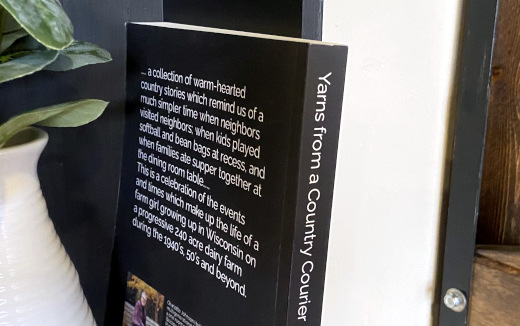My Takeaways From TekWar
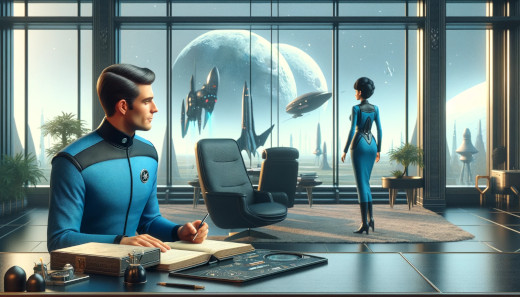
AI-generated image by DALL-E of someone writing a science fiction story
Not a day goes by when I don’t hear some comical reference to predictions that by 2020 we would have flying cars. Forecasting the future isn’t an exact science, but it can be fun to explore. Today some things are as they were predicted (like watch phones) and others are just not quite there yet (like living on the Moon).
What will life be like 100 years from? Will we finally have flying cars or something even better? Will we still have the societal problems today, will they go away or will be have completely new ones? All of this is explored in the science fiction book TekWar by William Shatner. Yes, the same William Shatner known for his role as Captain Kirk in the original Star Trek series, and beyond.
First published in 1989, TekWar is set in 2120. The hero of the novel is Jake Cardigan, a former police officer who is released from a futuristic prison early to work as a private investigator on a case. “Tek” is a futuristic illegal drug that got Jake in trouble and still plagues society. Where the technology of the time plays a key role in this story, it is the people and interactions with that technology that are core of the story.
But is it possible to have takeaways from the science fiction book? I sure did.
Did Shatner predict social media and print-on-demand books? – At one point in the story there’s mention about someone filming all the bad things in the city, and how it is presented sounded familiar to the livestreaming over social media that many – including myself – have done and continue to do. The concept of books printed on-demand, something that is a thriving business today, was presented in the story as done at the Dalton-Walden American Faxbook Centre (a nod to two now-defunct bookstore chains). Even android robots were able to print books from their abdomen.
The seedy side of life still exists – Where it would be nice to think that 100 years from now – or even in a shorter time period – the underbelly of society was reduced or eliminated. That wasn’t the case in TekWar, and my guess it won’t be when my descendants will be on this mortal coil.
Finally – There are flying cars in Shatner’s 2120, if that’s any comfort to you.
How I Learned About TekWar
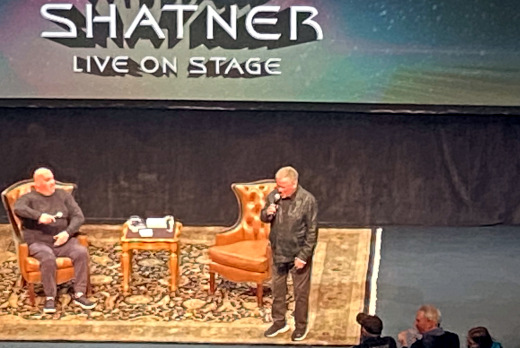
Last Fall William Shatner did a 5-city spoken word tour that kicked-off in none other than Appleton, Wisconsin, the city where I now call home. Why? I have no idea for sure, but the Fox Cities Performing Arts Center was the venue and was filled to about half-capacity for this unique show.
As it was in the midst of the actors and writers strikes, Shatner wasn’t even supposed to acknowledge any specific roles or characters he played by name. After a showing of the Star Trek II: The Wrath of Khan for which he was not “allowed” to even introduce, he took the stage for over 90 minutes of telling stories and answering some audience-submitted questions. At the young age of 92 on the night of the performance, he was not only animated and witty but an inspiration for anyone to be like him at that age, if we make it to that far.
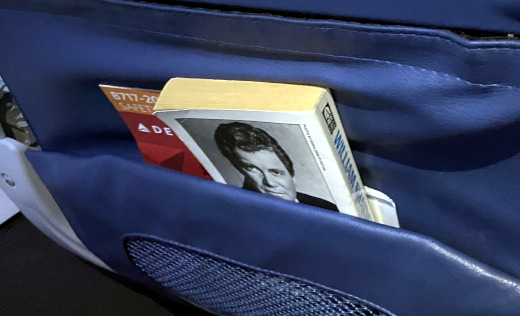
Shatner was, however, able to talk about TekWar during his dialog, the first of a series of science fiction novels he wrote. As I previously was unaware he was a writer (I was aware of his “singing” career, but I digress) I had to get a copy of it. A few days later I bought a copy at a used bookstore not far from the theater I saw him at and brought it with me on a business trip. As I share all books I read, I decided to leave TekWar in the seatback pocket of the flight I was on when I finished reading it. Hopefully someone was able to find it and enjoy reading as I did about the trails, tribulations and travels in the future.
This is from The Hot Iron, a journal on business and technology by Mike Maddaloni.
Did you enjoy this? Subscribe to The Hot Iron by RSS/XML feed or Read by Email
Book Take-Aways • (0) Comments • PermalinkMy Takeaways From The Creative Act
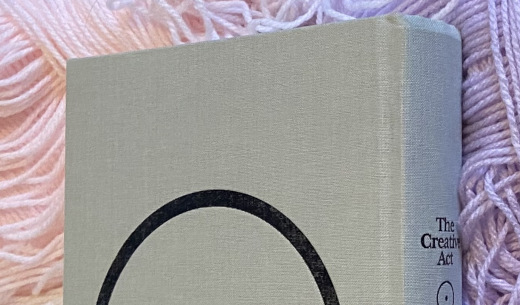
Are you creative? It’s a question that provokes different answers depending on who it is posed to. For some they would definitely have an answer to it, but for others they may wonder why it was asked of them in the first place. I have asked this of myself, someone who’s got his head down into a laptop computer most of his days doing whatever it takes to get through working in software technology. Then I will pull my head out of that laptop and look around me and remind myself that I am indeed creative.
Creativity comes in many forms, not just in output but in the process, or act. This is the theme of The Creative Act: A Way Of Being by Rick Rubin. Rubin is the legendary music producer who co-founded the Def Jam Recordings label and has worked with everyone from the Beastie Boys to Aerosmith to Johnny Cash and many, many others. Known for his eccentricity, last year he published this book of his thoughts on the creative process.
As I read through this unique book, I imagined how it possible came together: Rubin walking around his studio, barefoot, dictating his thoughts to someone following him around. Whether that was the case or not, his thoughts are presented in a unique way – there are dozens of “chapters” with some ranging from a couple of pages to more, but none too long. As I read through the book I was certainly inspired and had over a dozen significant takeaways, however I decided to refine the list to the following.
We all are artists – A pervasive theme throughout the book is that we are all artists. Often we think of artists as painters, photographers, writers, musicians... people who create things that are considered under the relatively rigid category of “art.” Often I sit back and look at a business or technical solution I have worked on for whatever time and even impress myself, finding a creative way to get from where I and my team are to where we want to be. Where nobody would be clamoring to have my work products from it framed and hung in a gallery, they have been deemed creative by others, so I would consider them art. I also consider myself creative with my time in improv and the writings here at this humble blog as ample examples.
Agile as art? – When I say “agile” I am referring to the philosophy/methods/approach/mindset of incrementally developing software and other products, often identified by frameworks such as Scrum and Kanban. With a goal in mind, a team of people are creating something, not necessarily knowing exactly what that finished product will look like. Where those on the team may not consider themselves artists or creative (nor others outside of a team looking at a bunch of business and tech types) this is not to say there is creativity and artistry in their work and process.
Ideas come from the outside, not the inside – This is an ethereal concept, where Rubin professes that ideas are out there, in the wild, and we recognize them and work with them. I’m not sure I completely agree with it, but he makes compelling points towards it. Perhaps the inspirations I would get when I walked along Lake Michigan in Chicago actually were in the air... along with the gnats buzzing around the shoreline?
Crafting – Rubin talks of how Andy Warhol did a lot of crafting, where he created an idea and had other artists execute on it. This triggered a pleasant flashback to 2006 when the Cloud Gate sculpture in Chicago’s Millennium Park was formally dedicated which I attended. During his speech the artist who created/crafted the artwork affectionately known as The Bean, Anish Kapoor, was repeatedly thanking the company Performance Structures, Inc. who took his idea and plans and actually built it. I just so happened to be in the crowd standing next to the president of the company, who was simultaneously blushing and beaming at the attention from Kapoor as he was pointing in our direction.
What is success to you? – Where many quotes from the book stirred something in me, this was especially did:
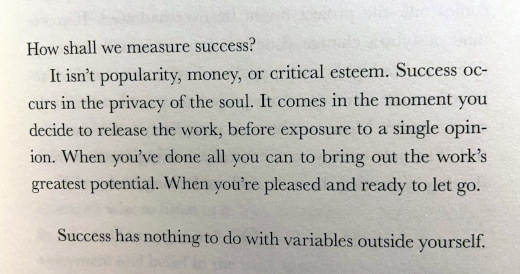
The quote reads as follows:
“How shall we measure success?
It isn't popularity, money, or critical esteem. Success occurs in the privacy of the soul. It comes in the moment you decide to release the work, before exposure to a single opinion. When you've done all you can to bring out the work's greatest potential. When you're pleased and ready to let go.
Success has nothing to do with variables outside yourself.”
When I have true success, I have felt this way. Do you agree?
“Comparison is the thief of joy” – This is a quote from the 26th US President Theodore Roosevelt, which is fitting from an individual there was really no comparison to in his lifetime.
I first learned of The Creative Act when I saw this video of Rick Rubin being interviewed by Anderson Cooper for 60 Minutes which is embedded below.
From my days in college radio I remember seeing Rubin’s name as the producer of many albums that came into the radio station. So last summer when on vacation and stopped into a locally-owned bookstore in northern Wisconsin and I saw the book in their collection, I had to buy it. I enjoyed it thoroughly, both in its format and collection of wisdom from a true modern guru. This is a book I recommend to everyone, whether you think you are creative or not (and if not, it may sway you). The destination for the giveaway of this book is a colleague and mentor who I feel is very creative in how he consults and educates... and I am pretty sure he concurs with my opinion.
This is from The Hot Iron, a journal on business and technology by Mike Maddaloni.
Did you enjoy this? Subscribe to The Hot Iron by RSS/XML feed or Read by Email
Book Take-Aways • (0) Comments • PermalinkMy Takeaways From Atomic Habits

(AI-generated image of a man thinking at an atomic level by DALL-E)
When I told friends I was moving to Chicago from Boston almost 2 decades ago, one said to me he was surprised; he saw me as a “Boston guy” and thought I would never leave. We talked about this over adult beverages, and I told him that it was a decision my wife and I made, and it came rather naturally and where we knew there would be a lot of logistics, we were eager to welcome this change in our lives.
That’s the funny thing about change – sometimes it’s easy, and many times it’s hard. Even when you know you have to make a change, that in itself may not be enough for some people. This thought process and changes in habits is what the book Atomic Habits by James Clear is all about.
Atomic Habits centers around 4 “laws” – evidence-based approaches in how to not just overcome but make lasting change, with reinforcements and stories to support them. I won’t go into detail on what those laws are, rather I will simply share my greatest takeaways from the book. If you are interested in detailed synopsis of the book, you can read it here on James Clear’s own Web site.
And those takeaways are...
Goals vs. Systems that lead you to said goals – The concept of goals in themselves have been getting a lot of scrutiny in both books and podcasts I have consumed, and I believe it’s with good reason. Many times goals are unrealistic or are structured to not account for change or outside influences. If you have a goal without the “system” that’s needed to meet it, there’s a likelihood it may never happen. Elements of said system are outlined in the books, and can range from the space or support needed to achieve it.
Add friction – When I read this, the first thing I thought of was how I don’t have the LinkedIn mobile app on my phone. Why? As it’s my last bastion of legacy social media, I don’t want to go to it constantly when I have a few minutes or need a diversion and get into an endless scroll. I can access it with a mobile Web browser, but the user experience is so horrible that when I do it, I don’t spend a lot of time on it. That friction is enough to help to stop wasting my time.
... With a little help from my friends – This reminded me of efforts in the past where I was involved in networking groups that helped keep progress to setting and making goals. Networking over the years like Circle of Progress and Business Forward were helpful. I also recalled when I was doing these and a colleague coined a phrase “accountabilibuddy” – though tongue-in-cheek, having someone who helps keeps someone else accountable can be the difference maker.
Orosensation – I always strive to find new words (to me) in books, and orosensation was one here, which means how something feels in your mouth.
Stronger Together – I read this book with another work colleague as part of a book club. I had put the idea out there to my team and though he was the only to respond, it was the others on my team who were at a loss as they missed an opportunity to collaborate on this book. It was a worthwhile experience, and gained a lot of insight on parts of the book that as seen through others. Thanks Kenny!
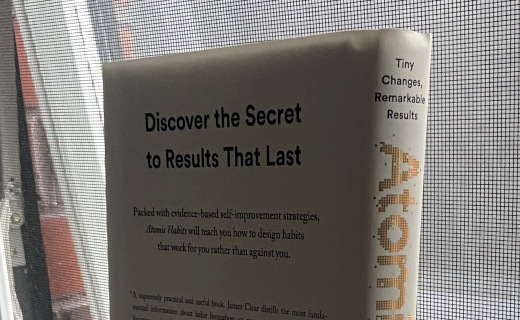
Since it came out in 2018, Atomic Habits has been a personal and business best-seller that I have heard many people talk about and have often seen it in prominent displays at bookstores and airports. After reading it, I know why. It is easy to read and relate to, and I recommend it anyone who is looking to make some change in their lives and it just isn’t sticking with them. The giveaway of this book is (I hope) serendipitous, as I left it in the seatback pocket on a recent plane ride. I hope someone came across it before the plane was cleaned (do they even clean planes that detailed these days?) and perhaps it can help make a difference in their life.
This is from The Hot Iron, a journal on business and technology by Mike Maddaloni.
Did you enjoy this? Subscribe to The Hot Iron by RSS/XML feed or Read by Email
Book Take-Aways • (0) Comments • PermalinkMy Takeaways From A Christmas Carol
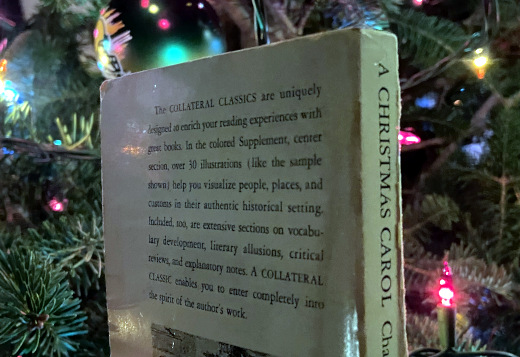
For as long as I can remember I have seen versions of A Christmas Carol performed. The classic Charles Dickens tale of redemption for the holidays has been performed in plays and on TV. Yet for as long as I can remember I have never read the actual text of the story. This is extremely ironic, as I have owned a copy of it since before I could even read! Yes, the picture accompanying this post was given to me as a child, and it has remained with me over the myriad of moves over my life. On a recent work trip I packed it in my carry-on bag to read on the flight.
Would reading the actual, non-adapted words of the author be unique experience from seeing George C. Scott amongst others reciting the words of Ebenezer Scrooge? And would it be possible to have takeaways from such a seminal story? Yes, and yes.
Enjoyed read the original story – It was a pleasure to read the actual words of Charles Dickens now over 180 years from when it was originally published. Where the presentation was classic British English, it was a nice contrast to the adapted and embellished narratives I have watch on big and small screens and live in such venues as the Goodman Theater in Chicago.
Staves not Chapters – Each of what I would traditionally consider a chapter in the book was called a stave. As I am unfamiliar with the term, I had to look it up. I found this great description of what a stave is, as it’s rooted in music, and relates to the title being a carol and thus a song. This is something I never picked up from any performance.
How to get the good out of other – I have always felt that most people have good at their core, and for whatever reason it has been hidden or warped by layers that have cocooned it over the years. In the original words that unraveling of Scrooge’s bitterness happens rather quickly upon encountering the Ghosts. From personal experience, however, people don’t change that rapidly. Then again, how many ghosts have they seen?
My copy of A Christmas Carol was published in 1966 and cost a whopping 50 cents. Illustrations from the period of the 1800’s when the book was written are included in each paragraph, er, stave. In the middle of the book is a “reader’s supplement” which includes additional notes and illustrations to help paint the picture of life in that period.
If you’ve never read A Christmas Carol and you are someone who celebrates the season as a religious or secular holiday, I highly recommend getting a copy of it. Where giving away to others what I read is a tradition here at The Hot Iron, I am going to pull a Scrooge and keep this copy in the home – I have owned it this long, and will pass it along to my family.
This is from The Hot Iron, a journal on business and technology by Mike Maddaloni.
Did you enjoy this? Subscribe to The Hot Iron by RSS/XML feed or Read by Email
Book Take-Aways • (0) Comments • PermalinkMy Takeaways From Yarns From A Country Courier
“There are eight million stories in the Naked City; this has been one of them.” That famous line is from the movie The Naked City, a story about a murder in New York City. Sure, in a city of that many people there are certainly that many stories if not more. But what about elsewhere? Take a more less-populated area, for example. Of course there are, and the book Yarns From A Country Courier by Charlotte Heikkinen is a collection of stories by this teacher / journalist from her life as she chronicled them in her newspapers columns over the years.
My interest in this book is rooted in the fact I know Charlotte’s sons, both of whom are of course mentioned in her stories. I bought a copy of this self-published tome from the author herself, as she setup a shop at a local community market. As I read through her tales of growing up in the rural Midwest, among the yarns of her life I had several takeaways.
A slice of history – The tales told here are much more than a personal story of one woman, but the story of how life was where she was at that time. These stories need to be told, and each one is a square in the vast quilt of history.
Know your audience – Just before I bought my copy of the book she was talking to the person in front of me who was buying their own copy. She told them the text is in big print to benefit her target audience of an older generation. As I write this post I am nodding my head getting used to my new bifocals, so I appreciate the attention to detail to have larger text on the page for her readers.
More encouragement to write my own – After reading the book I said to myself, as I have said before, “I need to write my own book.” I guess I can say I am making progress towards it one blog post at a time. And for as much as I encourage others to write and publish their own book, I need to start making a more concerted effort on my end.
Yarns From A Country Courier was an enjoyable read, telling the stories of life from the middle of the last century to the present. I especially liked the mentions of her sons, but I digress. For anyone interested in the personal nuances and challenges of rural life at that time, I highly recommend the book. As I pass along all books I read, I am passing it along to the parents of another friend of mine – I have enjoyed engaging in conversations with them over the years and have enjoyed their stories; perhaps after reading this they too may be motivated to write their own book?
This is from The Hot Iron, a journal on business and technology by Mike Maddaloni.
Did you enjoy this? Subscribe to The Hot Iron by RSS/XML feed or Read by Email
Book Take-Aways • (0) Comments • Permalink
